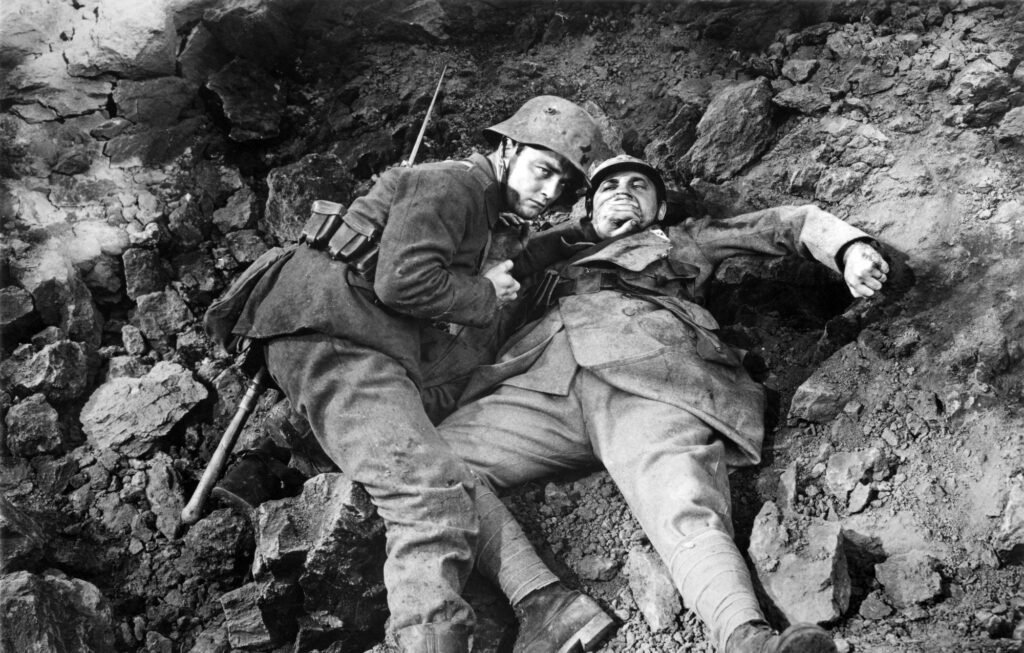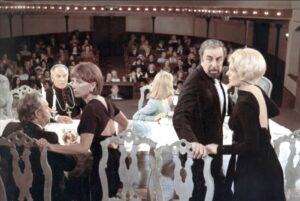
This weekend’s 95th Academy Awards celebrates the best of 2022 films from big-budget blockbusters to small independent films. Even if the Academy in recent years has spent less time celebrating the classic films it rewarded in years past to cut down on the ceremony’s running time, I thought it’d be a fun exercise to pair each of this year’s Best Picture nominees with a thematically similar film that would make for a great double feature. Some picks were no-brainers while others forced me to think outside the box a little bit.
To celebrate both the great achievements of current cinema and the classics, here is a classic film pairing for each of 2023’s Best Picture nominees.
All Quiet on the Western Front — All Quiet on the Western Front (1930)
Sometimes the most clear-cut choice is the best one; hence pairing two adaptations of Erich von Remarque’s classic World War I novel. While the 2022 German adaptation boasts stunning special effects to realistically capture the bloodshed of trench warfare, the 1930 adaptation does a much better job at capturing the novel’s beautifully bleak pessimism that pervades the forgotten soldier’s everyday life. Watching both back to back might be a bit dour of a double feature but would be a fascinating comparison of two adaptations of the ultimate anti-war book.
Avatar 2: The Way of Water — House of Wax (1954)
I could have been cheeky and paired Avatar 2 with Pocahantas or another film based on the movie’s well-trodden plot but I thought highlighting 3D would be a better way to go. House of Wax remains one of the funniest and most innovative 3D films that briefly entranced 1950s audiences, bringing them back to the theaters over the newly burgeoning medium of televisions. It might not have blue people swimming around but Vincent Price popping out of the screen is just as entertaining and worthy of the 3-D treatment.
The Banshees of Insherin — How Green Was My Valley (1940)
The Banshees of Inisherin follows a strained friendship as a backdrop to the Irish Civil War against the British in the 1920s. Set twenty years earlier and across the Irish sea in turn-of-the-century Wales, How Green Was My Valley recounts a boy’s childhood in a slowly modernizing mining town. Banshees is a less idealized recreation of old Ireland than How Green Was My Valley‘s romantic Wales but both films explore how rapidly modernizing wars and industries dramatically alter friendships, family, and community.
Elvis — Viva Las Vegas (1963)
Luhrman’s visually popping biopic of the great Elvis Presley quickly jumps over Elvis’s time in Hollywood and tosses off his dozens of films as empty commercial vehicles. While many of Elvis’s films were highly formulaic, several of his films successfully capture his star persona and none so more than 1963’s Viva Las Vegas starring Ann-Margaret alongside him. So go ahead, pause Elvis halfway through, watch Viva Las Vegas to see firsthand Elvis’ real-life star persona, and then finish the rest of the post-Hollywood era of Elivs’s life.
Everything Everywhere All At Once — I Was Born But… (1933)
Everything Everywhere All At Once is so entrenched in today’s cinema of multiverses it’s hard to pair with any specific classic film. Instead of trying to find a similar sci-fi comedy or even a dramatic classic film with plural realities or timelines, I decided to focus more on EEAAO’s central strained mother-daughter relationship; hence, a seemingly out-of-left-field pairing with the master of intimate family dramas Yasujiro Ozu’s work. Like EEAAO, I Was Born But... focuses on the conflict between antagonistic children rebelling against their very much unextraordinary parents. It might not be as anarchical or feature butt plugs and hot dog fingers like EEAAO but I Was Born But… features Ozu at his most humorous.
The Fabelmans — 8 1/2 (1963)
Known for his decades-long run of blockbuster classics, Spielberg turned to his own life to create the semi-autobiographically The Fabelmans, detailing his own upbringing making films and growing up in a fractured family. Federico Fellini, already a titan of cinema by the early 1960s, similarly turned inward for his avant-garde masterpiece 8 1/2 which follows a director struggling with producing a big-budget film as we weave through his recollections of his childhood and past relationships. Both films provide a rare look inside the lives and minds of two of the most revered film directors of all time. (Bonus points for Fellini’s work on Amacord beating out Spielberg’s work on Jaws in the 1976’s Oscars Best Director Category).
Tár — Patton (1970)
Cate Blanchett shines as the world-class composer in Todd Field’s Tár, a character study centered on how talent, power, and accountability intersect and conflict in modern creative circles. Set in the very different milieu of the World War II European theater, 1970’s Best Picture winner similarly centers on a complicated and vindictive protagonist navigating their own self-righteous ambitions with the social politics of peers and society. Whether Blanchett wins a lead acting Oscar like George C. Scott did is yet to be seen but both are the lynchpin for each respective film’s success in creating fascinating reflections on two very different turbulent time periods and industries. I guess that is why both films’ titles are merely their larger-than-life protagonists’ last names.
Top Gun: Maverick: Wings (1927)
Top Gun: Maverick‘s effective special effects and otherworldly tension and excitement owe a large part to featuring actors experiencing real-life G-force midflight. The first ever Best Picture winner Wings took a similar tactic, placing their stars not in fighter jets but in rickety World War I era biplanes that director William Wellman had flown during the war. Despite the almost century gap between the two, both films capture the camaraderie behind such dangerous and demanding machinery, making for a grand, popcorn-munching double feature.
Triangle of Sadness — The Discreet Charm of the Bourgeois (1972)
Ruben Ostlund’s Palme d’Or winning Triangle of Sadness aims fire directly at the ultra-rich, uncovering the facade of wealth and power to reveal their own greed, selfishness, and utter lack of morals. Luis Bunuel’s eat-the-rich ideology takes a slightly more farcical approach centering on six upper-class friends who face numerous bizarre obstacles when trying to set down and have dinner together. The Discreet Charm of the Bourgeois is much more dreamlike and has much less projectile vomit than Ostlund’s film but both don’t pull their punches when criticizing the class distinctions in modern society.
Women Talking: The Women (1939)
At first glance, there is almost nothing similar between Women Talking and 1939’s The Women. The former is a serious exploration of Mennonite women deciding how best to react to the sexual abuse perpetrated by the men in their patriarchal society while the latter is a light, classic-era Hollywood comedy centered on a woman’s struggle after divorcing her cheating husband. Even if their genres and tones are wildly different, both place the experience of women center stage and feature a lot of women talking (bum dum tss!). Start off with a challenging but rewarding women-centric film and relax and unwind with a bit lighter comedy full of some of classic Hollywood’s most iconic actresses.













